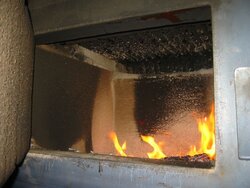So, it was about 50F today and has been around zero for the previous two weeks.
The Seton W-130 loves the cold weather (as long as you have alot of wood).
During the cold weather the refractory was always bright white and the HX tubes were relatively ash free.
Today the Seton cycled maybe three or four times being idle for about 80% of the 24 hour period.
So, when the Seton cycles now, I have the coked wood smell and the HX tubes are creosoting and collecting ash as shown in the attached picture.
Fred Seton told me the charcoal starter fluid trick for the HX tubes - get a hot fire going and leave the door open and then squirt charcoal starter on the HX tubes to really burn the creosote off - great fun too - especially after a few beers!
The charcoal starter fluid burns somewhat slowly and it did really lower my exhaust temps and increase efficiency.
Now, to the questions (while the storage tank HX funds are waiting to accrue):
1. With no storage and relatively light heat load, is it best to burn small pieces or large?
2. Is it better to burn down to almost nothing before adding more fuel?
Thanks,
Steve
The Seton W-130 loves the cold weather (as long as you have alot of wood).
During the cold weather the refractory was always bright white and the HX tubes were relatively ash free.
Today the Seton cycled maybe three or four times being idle for about 80% of the 24 hour period.
So, when the Seton cycles now, I have the coked wood smell and the HX tubes are creosoting and collecting ash as shown in the attached picture.
Fred Seton told me the charcoal starter fluid trick for the HX tubes - get a hot fire going and leave the door open and then squirt charcoal starter on the HX tubes to really burn the creosote off - great fun too - especially after a few beers!
The charcoal starter fluid burns somewhat slowly and it did really lower my exhaust temps and increase efficiency.
Now, to the questions (while the storage tank HX funds are waiting to accrue):
1. With no storage and relatively light heat load, is it best to burn small pieces or large?
2. Is it better to burn down to almost nothing before adding more fuel?
Thanks,
Steve


